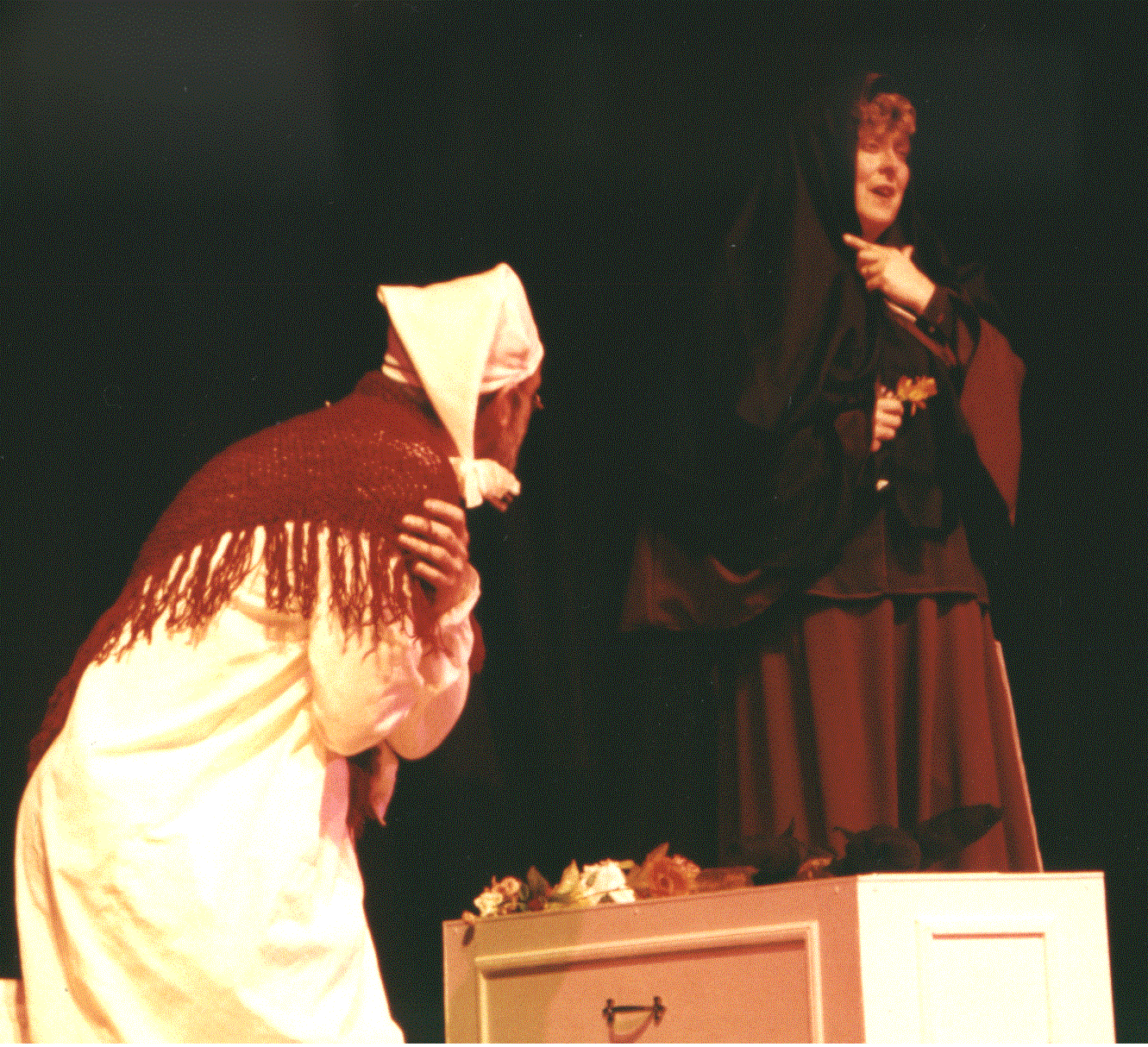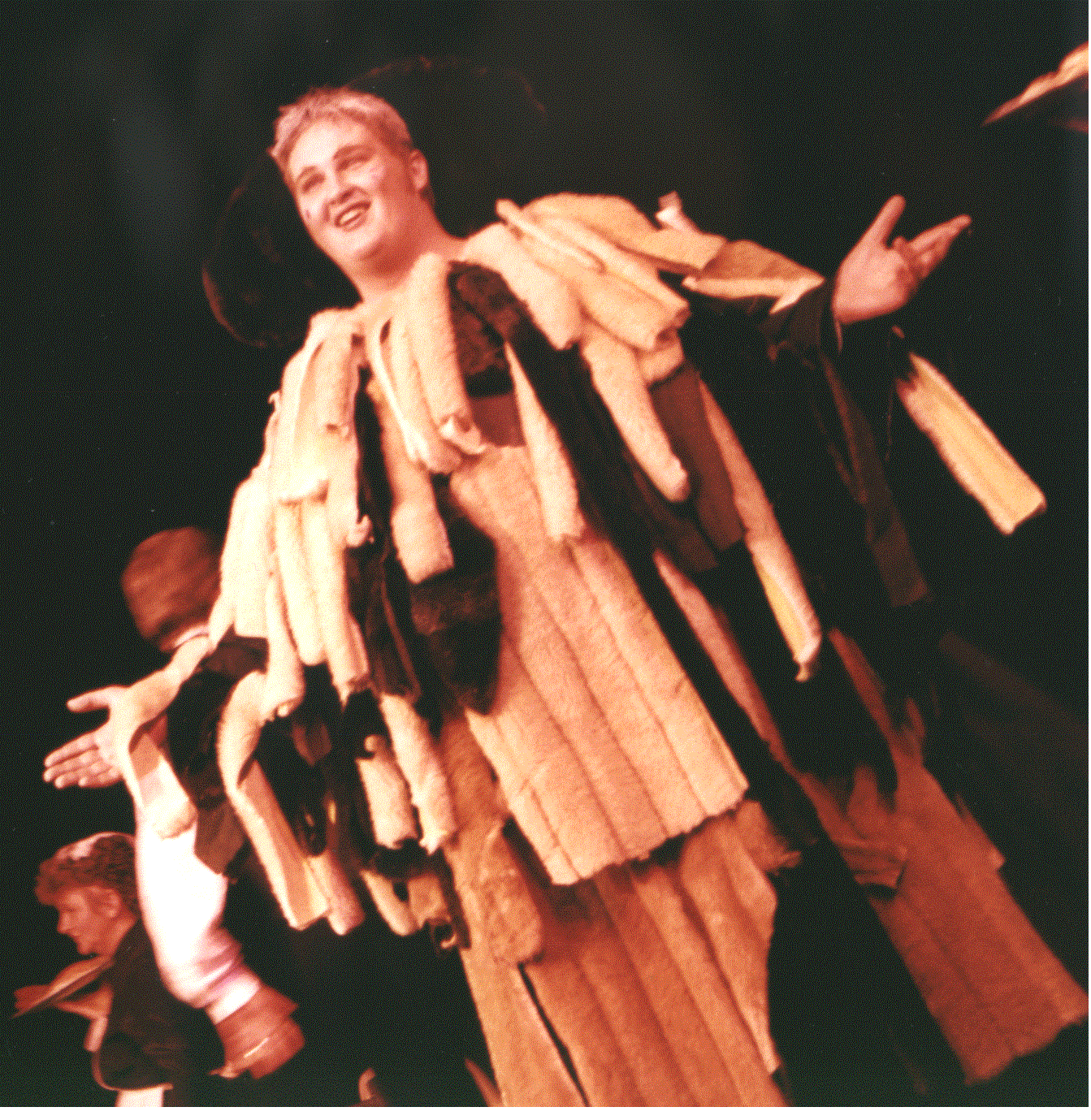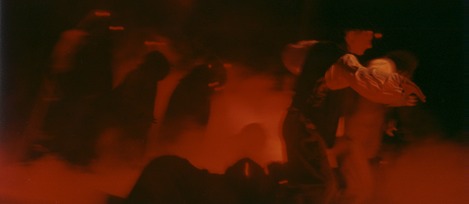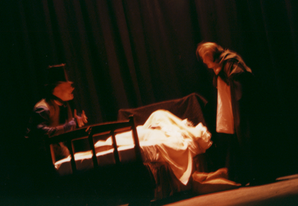Notes from the original production
All shows have their own particular challenges: the sinking in Titanic, the flying in the Witches of Eastwick, the tornado in the Wizard of Oz. And if you decide to put on such a show, you know up front what you will be facing in the way of these specific staging problems. Typically, G&S shows have very few of these types of technical challenges – the only one that comes instantly to mind is the portrait gallery in Ruddigore.
But what about the challenges you face when you decide to write your own G&S adaptation? When your group has no idea of what problems there might be ahead? This is the story of what happened to the Concept Players…

First of all - why did we decide to write our own show? The reason for the adaptation was that we’d run out of G&S shows to do. Someone - all right, I confess, it was me -thought it would be a good idea if we wrote our own. My initial thought was to write a G&S Pantomime, but what we ended up with was something much more exciting and challenging to put on. Working on the principle that if the Muppets and Bill Murray couldn’t kill the story, A Christmas Carol was a sure-fire winner – so that’s what we did!
For a group more used to the familiar topsy-turveydom of Gilbertian plots, the resulting adaptation of Dickens’ much-loved tale was something quite unfamiliar. An unpleasant leading character (who wasn’t King Gama), ghosts who didn’t come out of picture frames (and weren’t called Murgatroyd), a cast of thousands (well, twenty or so – they just seemed to play so many different characters!) – it was all so different from typical G&S!
And in fact, that was where the biggest challenge came. The main difficulty that we found with putting on this piece was that all the performers who had done any of the G&S operettas had to relearn the individual numbers using the ‘new’ words. But, having said that, at the end of the run, most of them found it really strange to revert back to Gilbert’s original lyrics!
The wandering minstrels

The Concept Players are peripatetic – which is an upmarket way of saying that we have no ‘home’ theatre, and that we’ll perform anywhere that will have us! So, as a consequence, our shows tend to be fairy minimalist, purely because of the logistics of carting props, costumes and scenery around. Performing a show for a short run, or even in a different venue each night, concentrates the mind wonderfully when you have to set up, perform and get out in a single evening! Of course, the answer is to use a minimal set, and create the atmosphere through sound and lighting – and Christmas Carol is perfect for this type of approach.
But as well as the challenges of a different set up each night, the cast have to be able to adapt themselves to differing stage layouts - and not just onstage. Sometimes, the consequences of getting the chorus and principals around a backstage area they’ve never seen before can be totally unexpected.
The semi-naked chorus
One of the features of the Savoy Christmas Carol is that it uses quite a bit of off-stage chorus. To do this successfully gave us lots of challenges, depending on the way the theatre was laid out. Ideally, we would have used a video link to communicate between the conductor and the chorus, but only one theatre we went to had that facility. Everywhere else, we had to improvise. We set up an omni directional microphone on a stand, and the chorus would gather around it, and someone (me, actually) would conduct them, so long as I had a sight line through the drapes to the conductor in the pit. This worked fine – except in one theatre, where the dressing rooms were so far from the side of the stage, that the ladies chorus mis-timed how long it would take them to get from the dressing room to the microphone. As a consequence, I was starting to panic that there would be no off-stage chorus when the whole of the ladies chorus came charging along the corridor in various stage of undress – and when I say undress, I mean that even the most decent of them had only underwear on. The vision of these ladies bathed in the blue light from the single lamp illuminating my score, and covering their bare chests with their hands, will never leave me. Has anyone out there ever tried to conduct a semi-naked semi-chorus? If so, please get in touch with me – we have so much to talk about!
But back to reality – how do you make three very different ghosts? And don’t forget Jacob Marley!
Marley’s parachute
Any theatre group worth its salt seems to have some boxes that appear in every production. Boxes are so useful: they can hold things, they can be used to make a set – and if they are collapsible (and I don’t mean by accident!) they can be pulled apart and packed into the back of a car. The Concept Players are the proud owners of some collapsible boxes, and in Christmas Carol one of them took the role of a chest in Scrooges’ bedchamber. We made a curved top out of thin plywood to make it look like a treasure chest, but really to hide a lamp inside. We made holes in the curved top so that when Marley’s Ghost had to appear, as the lights dimmed, the first thing that Scrooge noticed was a faint glow from the box, with increasingly strong beams of light darting out of it. Marley, played by a very flexible dancer, was hidden in the main body of the box, shrouded in a huge quantity of white silk – in fact, a parachute. As Marley was meant to appear, he slowly opened the lid of the box, a further light inside the box started to glow, and the parachute fabric started to billow slowly out. It was meant to look like ectoplasm, and with the right pink gel, and a small amount of smoke, we managed to make it look really eerie. Marley’s voice was supplied from off stage via the PA system, and the dancer’s movements were choreographed to his words. The whole scene worked a treat.
The colander ghost
I wanted the third ghost, the Ghost of Christmas Yet To Come, to appear out of the ground, and form itself before Scrooge’s eyes. Easy enough if you’ve got a trap door in the stage, but in all the venues we used, there was no opportunity to do anything like that. So we tried to think of a way to have a completely flat ghost that could be pulled by fishing line from above. A bit like one of those salad shakers can lie flat until you pick it up, when it forms itself into the right shape. Once the ghost had been raised to its full imposing height, we intended to have the actor slip into it from behind, and then give it form and movement from that point, reversing the procedure to allow it to collapse dramatically into the floor, once the actor had departed. I’m sure that if we had had enough time, we could have got it to work satisfactorily, but time ran out, and we had to make do with a ‘real’ ghost, and use the lights to allow him to fade in and out. It was astonishing just how little light we needed to make him look frighteningly supernatural, and how supplying just a little too much would make him look hilariously comic!
The battery-powered demons

In the second act, the chorus and some of the principals spend quite a long time as demons. We used black shrouds, black hoods and black gauze to cover their faces without affecting their ability to sing too much. We kept the lighting right down, and used a heavy smoke machine to give a carpet of fog over the stage. The dark shapes were suitable threatening, especially as they rose up out of the smoke and from behind the polystyrene gravestones. But to add impact, we gave them ‘eyes’ made out of red LEDs (bought from Maplins), and powered using small battery packs. The eyes themselves and their attached wires were threaded through plastic straws to allow them to be fixed to headbands, or in some cases sewn in to the hoods themselves. A small switch was taped to the battery pack which the demons held in their hands, with the wires fed along their sleeves and up through the hood to the headgear. This allowed the demons to switch their eyes on and off on cue, and we found that the red LEDs penetrated the smoke beautifully, giving laser like beams out into the darkness. Really scary stuff!
Smoke and no mirrors
We actually used two smoke machines during the performance; one was a normal machine that would leave smoke hanging in the air (suitable for foggy London street scenes), the second was a high volume machine that produced a layer of low smoke which covered the stage, and gave a very creepy graveyard with the right lighting. We even managed to hide the chorus under its thick layer. It didn’t do much for their singing, but to have these black-clad shapes emerge out of the ground cover was like something out of Michael Jackson’s Thriller! The problem we had with this low-lying smoke is that it runs downhill, off the stage and fills up the orchestra pit. The band disappeared from sight, and only the continuing music told us they were still there! How they managed to see their scores, I’ll never know – but afterwards they complained bitterly about my attempts to gas them – but as Gilbert wrote: ‘that’s so like a band’!

I mentioned the cast of thousands previously. In fact we did it with about 23 people in the chorus, but they had probably the busiest show ever. Apart from the naked chorus incident, the cast coped admirably with their many costume changes, and the fact that they were required to sing off-stage as well as on. And if you’ve ever done Oliver, you’ll probably have all the costumes you need!
I tried to make A Savoy Christmas Carol a fun show to put on. It has lots of chorus interest, there are opportunities for doubling many of the principal parts, and the selection of G&S numbers was made to allow the show to be as accessible as possible for the largest number of musical groups, and enjoyable for the audiences. Musically, it is very flexible, as it can be performed with a minimal set of instruments (piano/synthesiser with some sequencing), or can be augmented with additional players (even to the extent of using a small wind band on stage for Fezziwig’s Ball scene).
For those groups who specialise in G&S, A Savoy Christmas Carol provides an interesting and exciting supplement to the main body of G&S operettas, popular with performers and audiences alike. Why not try it, and see for yourselves?
[From an article published by NODA News]
A Savoy Christmas Carol is available from the publisher, Lazy Bee Scripts, website:
Or you can email them at: